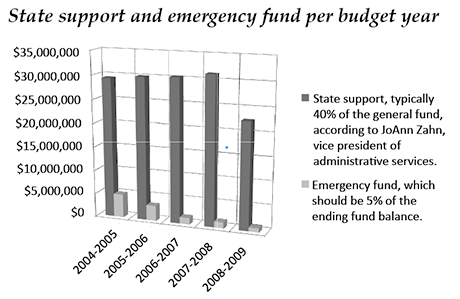
Town Hall meetings relay faculty, staff budget concerns
Ron J. Rambo Jr.
The Advocate
MHCC President John Sygielski held five town hall-style meetings this week to answer questions about the college budget and take a glimpse at a possible future with reduced state support.
Among the chief concerns of faculty and staff were two tax initiatives to be voted on in January that could leave MHCC, along with the rest of the education system, with less state support than originally planned.
According to June Jacobs, assistant to the president for strategic initiatives and Board relations, the January vote that could affect MHCC is “on whether to approve (and sustain the work of the Legislature) raising the corporate minimum tax and the tax for individuals making over $250,000.”
The $733 million would go to funding services such as education, health care, and public safety, the web site said. A vote to repeal the tax would affect MHCC adversely, Sygielski said.
“If voters approve those measures, things will be good,” said Sygielski. “If they aren’t approved, we’re looking at trouble balancing the budget. We might be looking at an additional $3 million in cuts.”
MHCC is already facing a reduced budget since the start of fall term. The college is looking at a loss of $2.5 million in each of the next two years from anticipated state support of $25 million, bringing the total in state support to $22.5 million per year.
Asked how low state support could go before the college faced a “cataclysmic” problem, Sygielski turned the question over to Vice President of Administrative Services JoAnn Zahn.
“Forty percent of our revenue is state support,” said Zahn. “Tuition has historically only been 25 percent. We can’t be below zero. We will cover our expenditures one way or another. We will ensure that we have enough resources to cover our expenses.”
Zahn later said tuition now makes up nearly 40 percent of MHCC’s revenue. After the question, Athletic Director Daryle Broadsword asked if a backup plan was in place in case a huge drop in state support were to happen.
“Do we have a plan if the reserves drop and we are not able to meet our current obligations?” asked Broadsword. “What if things do go south in January?”
Sygielski said neither administrators nor the district board had a plan.
“It’s something we wouldn’t want to think about, but we are getting to where we need to be,” said Sygielski. “We have not talked about it as a cabinet or board.
We have to be mindful of it. My hope is we won’t have to get to that point, because our constituency groups would come to the table and be selfless.
They’ve already given back, as everyone has, but more would have to be done.”
Sygielski later asked the crowd for ideas on how to get the message of the budget problems to the rest of the faculty and staff.
This was in response to a question asked about the idea that some faculty believe Sygielski is “crying wolf” about the budget being worse than it is.
“How can we get this message out?” said Sygielski. “Are there ways we can explain in detail what is going on with our state Legislature easier than we are already doing?
Even though we receive these budget cuts, business continues as usual. So how do we explain what happens with these cuts? The message is critical . . . and I hope to show everyone that we are transparent.
“People that have been here years and years have seen the ups and downs,” Sygielski said. “There are a lot of variables, so I don’t want to say the sky is falling, but it is critical that we are at least planning for the future.”
Sygielski spoke of hiring a grant writer in hopes of attaining more federal money for college projects. Broadsword issued this as one possible concern.
“One concern I see is the hope of federal dollars being given,” said Broadsword. “We’ve got to construct the message that this money isn’t replacing our operating budget. This is money given to us for construction and other help.”
Overall, Sygielski said, the three main concerns in the coming months were making sure the college is able to raise its low ending fund balance of 1.75 percent to 5 percent, getting the message out about the January vote and the problems that could arise, and getting college support looking at February legislative sessions in which additional cuts might be made.
“I haven’t talked to any peers who have a problem with reserve funds like we do,” Sygielski said of the 1.75 percent reserve fund. “We’re looking forward to moving our foundation into getting private corporation dollars and other forms of grants to get the reserves built up.
Some colleges are looking at creating a 20 percent reserve fund, so 5 percent for us is a place we need to be.”
![]()
The Advocate reserves the right to not publish comments based on their appropriateness.
![]()
Notice: Undefined variable: c5t_output in /hermes/walnacweb06/walnacweb06ac/b2874/moo.advocateonlinenet1/mhccadvocate/102309/N_Townhall.php on line 192
![]()
